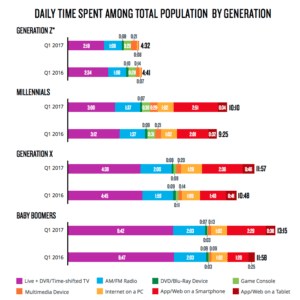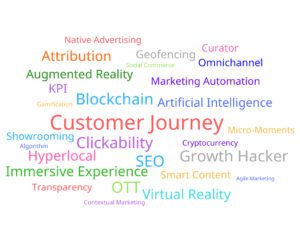Digital marketing strategy has evolved and with it the evolution of using big data. With the constant advance of technology and communications innovation, the advertising world struggles to keep up and develop marketing strategies that are in line with these constant shifts and improvements. This is especially true within the digital space. To get you up to speed on what is happening in digital marketing and advertising, we’ll look at this shift, and what the landscape looks like now. As stated at the Google IO 2017 Summit, “Everything is just a URL away.” The digital advertising space can be a scary place. The good news is that you don’t have to go it alone. There is a lot of support for new digital marketers as more and more marketing teams adopt digital advertising techniques, as echoed in this Wall Street Journal article. Some of the trepidation toward adoption is related to the myriad vendors and layers of tactics and data to sift through along with many platforms to be mastered. With this confusion, there are large chunks of money going missing as it goes from brand to end user (i.e. brand → agency → demand platform → data → supply platform → publisher→ end user). Each step takes a percentage of money and means giving less transparency to what actually happens in that path from brand to end user. Most in-house agencies don’t have the breadth of knowledge to do all of the things that are happening across the digital space and to know them all in depth, while executing everything perfectly. It often takes internal teams too much time and extra in depth know how to master and do it all.
What Does the New Digital Advertising World Look Like?
While many adjectives can be used to define the apprehension of novice digital advertisers, this seems to sum it up: It looks data heavy, platform laden, and time intensive. While these fears may be rooted in fact—the heaviness of the data, the plethora of platforms used, or the required time investment—these aspects of digital marketing also represent the first steps in transforming advertising from more an art to more a science. Digital advertising creates new opportunities and triumphs. Quite simply, as Voltaire once said (loosely translated): “With more power, comes more responsibility.” And, this sentiment is not far from the truth. The advent of this technology has enabled far more than was previously possible in advertising, so it makes sense that we would run into factors that can confuse or, even, downright scare many individuals. Specifically, the sheer scale of available data and trends that can identify you or your habits—yes, even you and your habits, dear reader. While this utilization of information and application of hard metrics are attributable to campaign performance, we must remember to keep in mind that campaigns are more complex than just focusing on a single number or metric. They must also take into account the actual human person we are talking to, where they may be in their buying or information seeking journey, and what messages will resonate best with them. Keeping a holistic approach to your campaigns is essential in this new digital age.
Buzzwords of 2018
Buzzwords are important and affect the “AdTech” industry in both simple and complex ways. On one-hand, buzzwords are just that: the proliferation of words or phrases that induce either fear or excitement or often both—think “blockchain”. Without this excitement there would not be any buzz. On the other hand, these buzzwords are often a sign of the industry landscape changing. That is, some new technique or technology is utilized in a brand-new way that causes pundits to questions how it will be used, and, ultimately, how it will be adopted (or if it ever will). Some of these common buzzwords are keywords and phrases you may recognize: native, mobile, mobile first, responsive, https, SEO, Google, Amazon, Facebook, and programmatic. However, there are many more.
Why the Shift? What Caused It?
Advertisers want to reach people where they are. Consumers are now in front of digital screens more than ever, so advertisers want to reach them using digital media. Since the average person spends more time on their phone or computer, advertisers must also shift their ad dollars to match where customer behavior. In the past, many of these ad dollars were focused on print ads, but with the changing landscape of the information world, these companies had to change their tactics with it. Since the end goal comes down to the selling products or services to individuals, it’s beneficial and strategic for savvy marketers to embrace this change. In fact, advertising must change because the way people are interacting with the world is changing. This idea is clearly supported by Nielsen’s 2017 Q1 Total Audience Report which outlines year to year increases in media consumption, as well as different consumption behaviors between generations. [caption id=“attachment_2593” align=“alignleft” width=“383”] Media Consumption Behavior Between Generations from the Nielsen Audience Report[/caption] We see overall high rates of smartphone usage, but each generation consumes their media differently. While the older demographic consumes far more television and radio, the younger demographic tends to consume more media on their personal devices. This indicates the need for an advertising shift that embraces change and that gradually moves away from traditional ads toward digital advertising. Stay tuned for our exclusive eBook download, “A Digital Advertising Technology Primer: The Dos, The Hows, The Whats” coming soon.
Media Consumption Behavior Between Generations from the Nielsen Audience Report[/caption] We see overall high rates of smartphone usage, but each generation consumes their media differently. While the older demographic consumes far more television and radio, the younger demographic tends to consume more media on their personal devices. This indicates the need for an advertising shift that embraces change and that gradually moves away from traditional ads toward digital advertising. Stay tuned for our exclusive eBook download, “A Digital Advertising Technology Primer: The Dos, The Hows, The Whats” coming soon.

